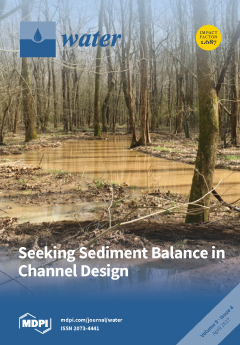A model of unsaturated soil-water movement using a prediction model of basic physical soil properties for calculating correlation functions was developed using VADOSE/W. The reliability of the model was assessed by comparing the results with those of a soil-column test. Coefficients of determination,
[...] Read more.
A model of unsaturated soil-water movement using a prediction model of basic physical soil properties for calculating correlation functions was developed using VADOSE/W. The reliability of the model was assessed by comparing the results with those of a soil-column test. Coefficients of determination,
R2, between the simulated and the measured daily evaporation for sand-mulch thicknesses of 0 (control, CK), 1.7, 3.6 and 5.7 cm were 0.8270, 0.8214, 0.8589 and 0.9851, respectively.
R2, between the simulated and measured cumulative evaporation for mulch thicknesses of 0, 1.7, 3.6 and 5.7 cm were 0.9755, 0.9994, 0.9997 and 0.9983, respectively. The fits were, thus, good, verifying the reliability of the model. The program accurately predicted the distribution of cumulative evaporation and volumetric water content during evaporation from a soil column with mulch thicknesses of 1, 1.3, 1.5, 1.7, 2, 3, 5 cm and depths of sand inclusion thick of 0, 5, 10 and 15 cm for 20 days. Cumulative evaporation of sand inclusion was lower than in CK. Cumulative evaporation was independent of the mulch thickness and depended only on the depth of the inclusion: the deeper the inclusion, the higher the evaporation. The best mulch thickness was 5 cm, and the best inclusion depth was 5 cm. This study offers a new method to study the evaporation process with sand mulching and inclusion, which can provide guidance for improving the utilization efficiency of soil water.
Full article





